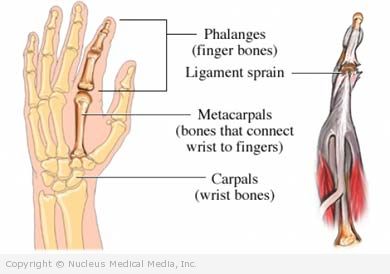Finger sprain – Definition
A finger sprain is stretching or tearing of the ligaments that support the small joints of the finger. Ligaments are strong bands of tissue that connect bones to each other.
Finger sprain – Causes
A finger sprain usually results from a blow to the finger. This often occurs during athletic activity when an athlete jams a finger into another person, the ball, or piece of equipment. Finger sprains may also occur in other situations, such as falling on the hand.
Finger sprain – Risk Factors
A risk factor is something that increases your chance of getting an injury. Risk factors for a finger sprain include:
- Playing sports, especially those involving the hands, such as basketball or volleyball
- Poor coordination
- Poor balance
Finger sprain – Symptoms
Symptoms include:
- Pain and tenderness in the finger
- Pain when moving the finger joint
- Swelling of the finger joint
Finger sprain – Diagnosis
The doctor will ask about your symptoms and how you injured your finger. The doctor will examine your finger to assess the stability of the joint and the severity of the injury.
Tests may include:
- X-rays — a test that uses radiation to take pictures of structures inside the body to make sure that no bones are broken
- MRI scan — a test that uses magnetic waves to make pictures of structures inside the body, used in some situations to see if a ligament has torn completely (rarely needed)
Finger sprains are graded according to their severity:
Grade 1
- Stretching and microtearing of ligament tissue
- Stable joint
Grade 2
- Partial tearing of ligament tissue
- Mild instability of the joint
Grade 3
- Severe or complete tearing of ligament tissue
- Significant instability of the joint
Finger sprain – Treatment
In consultation with your doctor, treatment may include:
Rest
Avoid using the injured finger.
Ice
Apply ice or a cold pack to your finger for 15-20 minutes, four times a day, for several days or until the pain and swelling goes away. Ice helps to reduce pain and swelling in the sprained finger. Wrap the ice or cold pack in a towel. Do not apply the ice directly to your skin.
Compression
Wrap an elastic compression bandage around your finger. This will limit swelling and support your finger. Be careful not to wrap too tightly because it can cut off the circulation to your finger.
Elevation
Try to hold the injured hand above the level of your heart as much as possible for the first several days or until the swelling goes down. (For example, place your hand up on a pillow.) This will help drain fluid and reduce swelling.
Medication
The doctor may recommend:
- Over-the-counter pain medicine (eg, ibuprofen, naproxen, acetaminophen, aspirin)
- Topical pain medicines (eg, cream, patches) that are applied to the skin
- Prescription pain medicine
Splinting and Taping
You may need to wear a splint to immobilize your finger. If you play sports, you may need to tape your finger to the finger next to it when you return to play. Your doctor can show you how to splint or tape your finger.
Surgery
Surgery may be needed to repair a finger sprain if:
- A small piece of bone has been broken off by the injury to the ligament.
- A ligament is torn completely.
If you are diagnosed with a finger sprain, follow your doctor’s instructions.
Finger sprain – Prevention
You can reduce your risk of getting a finger sprain by learning and practicing correct technique in sports and using proper equipment. However, in many cases, sprains cannot be prevented.

